Welcome to a pilot of a new series of comic book posts on Crushing Krisis – Back Issue Review!
If I tried to complete my quest to read 2018 comic issues in 2018 purely by keeping up with new releases, I’d have to read 39 new comics every week!
Since my pull list isn’t quite that deep, I pad out my new release reading (and my playing catch-up to get current with new releases) with a healthy amount of back back issue reading, both from my own ridiculously deep collection and in browsing for digital deals.
Here’s the rundown of the back-issues I’ve read this week and reviewed below:
- Alan Moore’s The Courtyard (2003) #1-2
- Aquaman (2016) #1-6
- Avengers/Champions: Worlds Collide (Avengers #672-674 & Champions #13-15)
- Captain Canuck (2015) #1-2
- Captain Marvel (2016) #6-10
- Civil War II (2016) – The Oath
- Dark Ark (2017) #1-4
- Freelance (2017) #1
- Grimm Fairy Tales: Return to Wonderland (2007) #0-3
- Judas (2018) #1
- Monstro Mechanica (2017) #1
- Port of Earth (2017) #1-2
- Realmwalkers (2017) #1-3
- Silk (2016) #14
- Spencer & Locke (2017) #1-4
- The Skeptics (2016) #1-4
- Toil and Trouble (2015) #1
Interested in what I have to say about other random pulls? Leave a comment about a series you’d love to see me dig into in the coming weeks. Given the scope of my collection, you might be surprised to learn I already own a copy!
Alan Moore’s The Courtyard (2003), Avatar Press
Issue #1
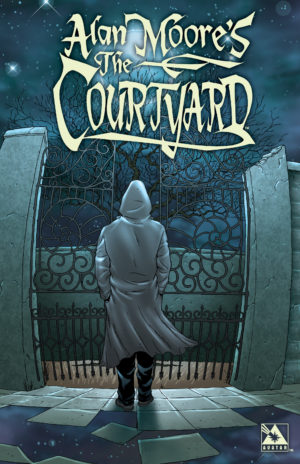
![]() Really, Alan? Starting this comic with a big old N-word drop? I’m not sure his curmudgeonly lead investigator earns it – you can be a brilliant asshole without being an irretrievable racist, and being irretrievably racist isn’t just a fun character trait.
Really, Alan? Starting this comic with a big old N-word drop? I’m not sure his curmudgeonly lead investigator earns it – you can be a brilliant asshole without being an irretrievable racist, and being irretrievably racist isn’t just a fun character trait.
That complaint aside, this comic crackles as our investigator puts together his Anomaly Theory over Jacen Burrows pencils that suggest Garth Ennis. Not much happens aside from attending a concert, but if you know your Lovecraft there are tons of mentions of his universe throughout.
This is better than your average black and white crime comic. I’m eager to see just how hard it cuts into Lovecraftian lore next issue.
Issue #2
![]() Hey, let’s keep up the tradition of dropping hardcore ethnic slurs on page one!
Hey, let’s keep up the tradition of dropping hardcore ethnic slurs on page one!
In this issue, script adaptor Antony Johnston is trying way too hard to recapture Rorschach’s voice for no reason in particular. It goes off the rails pretty hard, confirming nothing of the mysteries of the FBI files unfurled at the end of the last chapter. It’s pretty much entirely comprised of our protagonist paying for one kind of drug trip and getting a totally other kind of trip that confirms all of his theories in the worst kind of way.
It’s not particularly rewarding, although it does look good throughout. (After I was finished reading these, I realized they were also available in color. Oops!)![]()
Aquaman (2016) #1-6, DC Comics
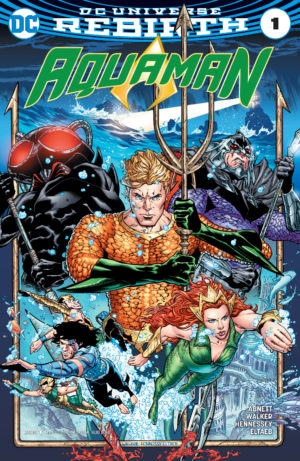
![]() This run begins with a slam bang first issue that is worlds better than the slow-moving Rebirth special. However, this run is drawn by a merry-go-round of three different artists, all of whom are good but none of whom draw a lot like each other. I suppose the linking method here is keeping the same colorist, which does introduce a surprising amount of consistency, but at a point Aquaman looking different each time is a little confusing.
This run begins with a slam bang first issue that is worlds better than the slow-moving Rebirth special. However, this run is drawn by a merry-go-round of three different artists, all of whom are good but none of whom draw a lot like each other. I suppose the linking method here is keeping the same colorist, which does introduce a surprising amount of consistency, but at a point Aquaman looking different each time is a little confusing.
The plot starts out a bit on the “blah” side. We follow two visitors to the new Atleantean embassy, which doesn’t make for much of an Aquaman comic. Yet, they let us see Aquaman’s world and mission through their eyes, which helps set up a predictable but still chilling twist towards the end of the first issue – Black Manta!
A fight with Black Manta could easily wind up playing out as the same bad guy fight that’s been in his comic forever. Author Dan Abnett understands that, and gives us the fight but also its rebuttal – a reminder of how silly this unending conflict between Aquaman and Black Manta (or, really, any set of arch-nemeses) is. That makes for a much more interesting resolve than we could have been in for otherwise and leaves us with an interesting status quo – Aquamans’s special embassy is shattered, and all the intended stability that came with it.
From there, the story gets a bit too dumb for me. It’s all misunderstandings and missed connections, but also literally playing Aquaman as completely blithe to the customs of the human world. Aquaman thinks you get an appointment at the White House by just walking up to the gates at the same time he leans on years of experience with the JLA as part of his defense of himself as a well-meaning actor on the world stage. You cannot have it both ways, nor can you have the goofy confusion of a terrorist group representing Atlantis being seen as synonymous with Aquaman.
This all results in the sorts of throw-downs you might expect. I suppose in the “comics are for kids, too” category I should probably be fine with this, but it’s such a goofy, lazy way to get the plot to where Abnett is driving that I cannot contain my annoyance.
Luckily, the arc ends with the joy of Aquaman and Mera beating the tar out of Superman, who tries to explain that he’s being the mediator here but cannot help but be seen as an extension of the US Government. It puts a personal face on the comedy of errors we’ve seen so far in this arc, and makes it all the more satisfying since it leads to characters we love coming to blows rather than an argument with a chief of staff.
(Of course, little is said of the fact that this Superman has only known this Aquaman for a few weeks, since this is assuredly before Superman Reborn, but, well, Abnett can only do so much in one issue).
Overall, I like where this arc has left us, both with Aquaman besieged both from land and from within, and Black Manta infiltrating NEMO.![]()
Avengers/Champions: World’s Collide:
Avengers (2017) #672-674 & Champions (2016) #13-15, Marvel Comics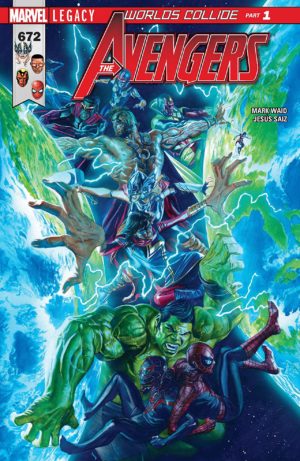
![]() This team-up story written entirely by Mark Waid was marketed as an inevitable clash between the two teams who were separated by Civil War II. IN reality, it’s a much more anonymous superhero story except for a heavy focus on Vision and his daughter Viv and the divide between them in the wake of Tom King’s brilliant The Vision series (which Waid also touched on in Champions).
This team-up story written entirely by Mark Waid was marketed as an inevitable clash between the two teams who were separated by Civil War II. IN reality, it’s a much more anonymous superhero story except for a heavy focus on Vision and his daughter Viv and the divide between them in the wake of Tom King’s brilliant The Vision series (which Waid also touched on in Champions).
The teams converge at the start due to a peculiar set of gravitational vibrations causing catastrophes around the world. Tese two teams in particular don’t make the most sense to deploy all around the world to save vibrating high rises, but I suppose heroes gotta hero. Even if this opening portion of the story is written in a somewhat anonymous voice, it gave us a lot of fun interactions – included Herc and Cholk reunited!
The vibrations turn out to be the work of High Evolutionary and his Counter-Earth. Waid has maybe the most coherent explanation of how Counter-Earth works of any recent use of the concept (as in Remender’s second volume of Uncanny Avengers). However, his way of executing it makes the plot extremely derivative of Hickman’s run on Avengers (not just his incursions, but also his Rogue Planet plot).
Jesus Saiz delivers a stunning, covers-caliber job on art in the opening installment in Avengers #672, including probably the best we’ve ever seen this Champions team look. He’s back again in #674 after an attractive issue from Paco Diaz and Javier Pina in the middle.
The plot devolves into a series of low stakes(in terms of actual battle) fights intercut with a philosophical journey by Viv as she argues evolution with High Evolutionary and then searches for one of his offspring.
I’m not typically a fan of Humberto Ramos (who has drawn all but two issues of Champions), but I’m shocked to say that he turns in a beautifully controlled final chapter in Champions #15 of all talk. I really enjoyed it. Surprise, right? It’s not really a proper part of the crossover so much as it is a little coda on The Champions side of things, and it’s mostly Viv arguing with High Evolutionary before… well, that would be a spoiler.
You can easily skip this to get to “No Surrender” in Avengers, which is somewhat repetitive of this story (which, again, is highly repetitive of Hickman). I think its developments will prove to be much more important in Champions, and this could be a logical next read for fans of Viv from The Vision who want her next big development.![]()
Captain Canuck (2015), #1-2 Chapterhouse
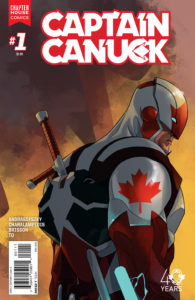
Issue #1
![]() A rousingly good first issue with beautiful art, a well-defined cast, action, and a mystery.
A rousingly good first issue with beautiful art, a well-defined cast, action, and a mystery.
This was strongest on the parts that focused on Canuck and his rapidly-failing super-suit, and weaker in the mysteries of Canuck’s brother and his secret society. Those parts were still good, and introduced some intriguing mystery – and, it’s probably for the best that an initial issue from a new publisher wasn’t all instant gratification.
I’m suddenly very eager to learn more about Chapterhouse’s shared Canadian universe of comics!
Issue #2
![]() This remains incredibly strong and fun for a small-press comic. There’s some shuffling on art midway through the issue that leads to a bit of confused narrative, as if the script isn’t lining up perfectly with the panels. It only lasts for a page or two, and going back through it I could tell what happened just fine.
This remains incredibly strong and fun for a small-press comic. There’s some shuffling on art midway through the issue that leads to a bit of confused narrative, as if the script isn’t lining up perfectly with the panels. It only lasts for a page or two, and going back through it I could tell what happened just fine.![]()
Captain Marvel (2016) #6-10, Marvel Comics
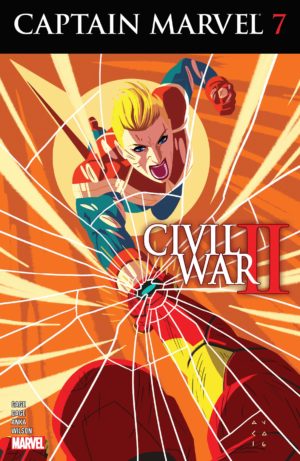
![]() This is a sadly procedural run of Captain Marvel with no joy in it, and nothing that feels individually or remarkably true about Carol Danvers.
This is a sadly procedural run of Captain Marvel with no joy in it, and nothing that feels individually or remarkably true about Carol Danvers.
It makes sense that Carol’s own title would function as a propaganda parade for her part in Civil War, so Ruth Fletcher Gage and husband Christos were called in to figure out how to justify Carol being the villain in Civil War II after Brian Bendis already had the major beats of the event mapped out.
This arc began with Captain Marvel taking care of an inconsequential little bit of repairs on the outside of Alpha Flight station and being admonished by Puck that a robot could do it. It feels like the perfect metaphor for the entire arc.These are things we could have just assumed had happened based on reading Civil War II. A robot could write them.
Yes, getting these vignettes of Carol’s increasing reliance on predictive policing helps show that her descent into outright villainy in Civil War II was a gradual one, but not one of these moments ultimately really matters to Carol. They’re not adventures that will be referenced in future flashback. They’re unimportant moments, little administrative repairs we could have implied on our own.
This story has to be at least a third comprised of her appearing with a clenched jaw before her Alpha Flight steering committee, which acts as a microcosm of the world governments slowly coming around to the power of harnessing a precognitive Inhuman.
Carol goes from the one who is tempering their enthusiasm to the one who has doubts after a mission to disarm a former supervillain who unintentionally put his family in danger by hanging on to an old villainous artifact. This combines with Carol’s guilt over Clint Barton preemptively taking out Bruce Banner when they weren’t even in the same location his Hulk rampage was to take place.
It’s nice to see this kernel of doubt planted in Carol, but I can’t help but reflect that it feels like she was written better in this period in her supporting role in books like A-Force and Spider-Woman. While this title is doing an okay job at giving Carol a realistic motivation, it doesn’t feel especially important to her ongoing life as a character or significant in any way. She very much feels editorially placed into certain situations (Alpha Flight, Ultimates, Civil War) where she’s just filling a role.
Perhaps it would be more exciting with better artwork? Kris Anka is a marvel at covers and costume redesigns, but his panelling and figure-work leave a lot to be desired. None of the fill-in artists that alternate with him bring anything remarkable with them. By the final issue the Gages finally let Carol be Carol and act on her gut rather than be a slave to Ulysses’ predictions and the Civil War II storyline, but it’s a long slog to get there.![]()
Civil War II (2016) The Oath, Marvel
![]() This is a beautiful, horrible comic book.
This is a beautiful, horrible comic book.
Writer Nick Spencer has a good thesis in Captain America’s argument against superheroes pretty much equating to an argument against a liberal elite – that once they break free of the chaff they never look back, never stop to elevate them. And, all of the little vignettes with other characters (Hawkeye, Captain Marvel) provide interesting insight to where they wound up after the War.
Yet, the book is dead on arrival, because it’s almost entirely Nick Spencer monologuing as Secret Hydra Cap. I feel bad for him. He has this brilliant idea for Captain America, but as this comic and the Steve Rogers series show, somehow he cannot execute upon it. I don’t know if he feels the need to explain himself or he thinks the monologues are good reading, or what, but they are awful.
On the plus side, the art is spectacular throughout – incredibly strong across the entire roster of artists with phenomenal colors (including a break with the duller, washed out colors when we get to the Oval Office, which somehow made sense to me).![]()
Dark Ark (2017) #1-4, Aftershock Comics
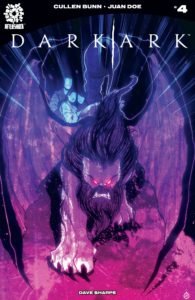
![]() From writer Cullen Bunn (meh) and artist Juan Doe (hooray), an utterly fascinating concept that there was more than just Noah’s Ark in the biblical flood.
From writer Cullen Bunn (meh) and artist Juan Doe (hooray), an utterly fascinating concept that there was more than just Noah’s Ark in the biblical flood.
Everything about this book is a delight, from the hordes of fantastical creatures to the very human drama playing out both above and below decks. Bunn’s script is snappy and the many creatures feel distinct, and Doe’s art is incomparable (I also loved him on World Reader) – he’s not always the best on human faces, but possibly the best on monsters.
This comic begins with a debut issue that is packed with information and tension in every scene. It’s fascinating world building that tells you thinks that extend past the hull of the ark. Bunn introducing conflict via a whodunit, which leads things on the ship to escalate quickly and horribly. I think the scope of that horror get a little out of hand to keep your disbelief suspended, but that’s a minor quibble with a terrific comic.
To say more would spoil things. The freshness and viciousness of this book never ceases to amaze.![]()
Freelance (2017) #1, Chapterhouse
![]() I actually read this first and then went back for Captain Canuck, above. It’s a pleasing first issue that is high on action and short on information. The art has a sort of manga quality to it that works well, though that varies a bit with the quality of the colors (which falter in the second sequence, looking a bit bland and flat without as many lighting effects as at the start).
I actually read this first and then went back for Captain Canuck, above. It’s a pleasing first issue that is high on action and short on information. The art has a sort of manga quality to it that works well, though that varies a bit with the quality of the colors (which falter in the second sequence, looking a bit bland and flat without as many lighting effects as at the start).
I’m not sure sure what to think of the story from Zub and Wheeler. I loved the introduction of this three person team – the sexy agent, the tech lady, and the efficient killer. I didn’t expect to pivot towards the tech lady, of the three of them, which was refreshing if not as rewarding as a focus on one of the other two characters.
We learn a shade more about her and do get an intriguing mystery about her, but as a result it feels like we still don’t really know anything about who Freelance is or why he’s doing what he does. I don’t need every mystery to be solved right away, but this feels like half of a first issue with half of a second or third issue tacked on.![]()
Grimm Fairy Tales: Return to Wonderland (2007), Zenescope
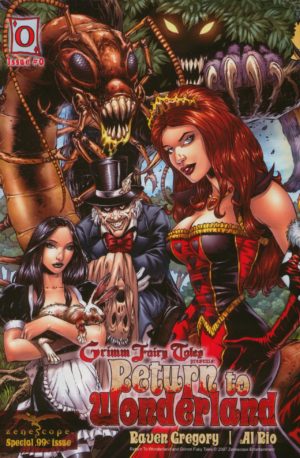
Issues #0 & 1
![]() I was surprised by the strength of this book. I always thought Zenescope was all about T&A all the time, but between the prologue vignette in the #0 issue and this first issue there is a solid horror fantasy book lurking between the breasts and exposed thong straps of the artwork.
I was surprised by the strength of this book. I always thought Zenescope was all about T&A all the time, but between the prologue vignette in the #0 issue and this first issue there is a solid horror fantasy book lurking between the breasts and exposed thong straps of the artwork.
We meet the literal Alice of Alice In Wonderland, now a grown woman who could never find “happily ever after” even with a perfect American family. Even after trying to commit suicide. Now, she spends her days wordless, stroking a white rabbit while her family falls apart.
The artwork isn’t particularly notable for a mid-00s book, but it’s pleasingly consistent with strong colors – enough so that it doesn’t feel too dated to read it a decade later.
Are the sexpot daughter and gore-obsessed son a bit much? Sure, but at least the series took the time to frame their behavior with their mother’s suicide attempt rather than just inserting it for show.
Issue #2
![]() Can we talk about how much I loved the first few pages of this comic book?!
Can we talk about how much I loved the first few pages of this comic book?!
Alice’s daughter Caroll encounters the same initial situation in Wonderland as her mother all those years before – the tiny door, the high table, the potion to drink. Except, Caroll is having none of it, and refuses to participate – until she’s goaded into it by her unseen narrator, aping the narration of the original book.
When she finally goes through the motions – getting small, getting large again, crying, and floating outside on her tears – we see that her flood has killed tons of cute little ground animals in Wonderland!
I love this twisted vision. The rest of the issue isn’t quite so straightforward of a romp through the major beats of Alice, and Caroll doesn’t have much agency aside from running, but it all looks great and its cleverness has given me a lot of good will to use to ignore all of the expose g-string straps and bosoms.
Issue #3
![]() Things take a turn for the much worse in this issue. Not only has the art lost much of its glossy, perfect sheen, but the trip through Wonderland has gone the original Alice route and just unfurls without our protagonist having too much choice in the matter. That ends up with her in the Mad Hatters house, except he’s some sort of depraved rapist and she decides she has to beat him to a blood pulp.
Things take a turn for the much worse in this issue. Not only has the art lost much of its glossy, perfect sheen, but the trip through Wonderland has gone the original Alice route and just unfurls without our protagonist having too much choice in the matter. That ends up with her in the Mad Hatters house, except he’s some sort of depraved rapist and she decides she has to beat him to a blood pulp.
This is the sort of pointlessly rapey, extraordinarily bloody book I was expecting from Zenescope.
![]()
Judas (2018) #1, Boom! Studios
![]() Jeff Loveness and artist Jakub Rebelka tackle the biblical Judas with gorgeous, thought-provoking results. This first chapter is largely a canonical one, reviewing Judas’s life, his love of Jesus, his betrayal, and his eventual death.
Jeff Loveness and artist Jakub Rebelka tackle the biblical Judas with gorgeous, thought-provoking results. This first chapter is largely a canonical one, reviewing Judas’s life, his love of Jesus, his betrayal, and his eventual death.
Those events are interrupted by what reveals itself to be Judas’s descent into a biblical hell. Rebelka’s artwork here is beautiful. Distinct figures inhabit a dusty, detailed world which dissolves into the abstract in the bluish cast of the underworld.
Yet, the most powerful aspect of this issue for me was thinking about free will from Judas’s viewpoint. Was he always doomed to live his life as a mere accessory to the second coming? If he was, did his life have any meaning? Does anyone’s? And, is it fair that he be doomed to eternal suffering for playing his assigned role?
The last page partially answers that final question, but we won’t fully understand how until the next issue.![]()
Monstro Mechanica (2017) #1, Aftershock Comics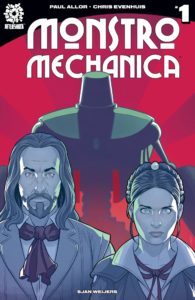
![]() I’m getting darn close to auto-buy status on Aftershock’s Titles after loving a string of them, including Babyteeth and Dark Ark, so now I’m pretty much in for anything for an issue or two.
I’m getting darn close to auto-buy status on Aftershock’s Titles after loving a string of them, including Babyteeth and Dark Ark, so now I’m pretty much in for anything for an issue or two.
This story finds us following a version of Leonardo DaVinci who is as slick as Bruce Wayne. I know DaVinci really was the superhero of his time, but I feel like between TV’s Alias and Hickman’s SHIELD I’ve had enough takes on him as Batman and Iron Man combined in medieval times.
What maybe sets this series apart is that it also focuses on his assistant, Isabel, and frames his life within an ongoing struggle not to divulge all his secrets to the Medicis. This Stark-like DaVinci is playful and cunning, as is his pants-wearing assistant, determined not to be held back by her gender.
The entire book is absolutely beautiful. Line artist Chris Evenuis gives me shades of Yannick Paquette and Mike Janin, drawing clean, beautiful faces and intricate period costumes all with bold, black outlines. This guy is BIG LEAGUES caliber – someone DC and Marvel ought to be chasing for Star Wars or Batman, respectively. I’m not sure this comic would have the heft and delight that it does without him and Sjan Weijers colors.
I’m going to keep reading on the strength of the art, as I’m not sure a tale of DaVinci’s surreptitiously sentient robot really grabs me otherwise. I’m also not sure I love the lettering from writer Paul Allor, which is a little overly large and bold for each word balloon.![]()
Port of Earth (2017) #1-2, Image Comics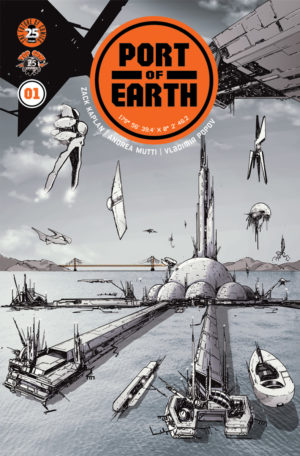
Issue #1
![]() This comic book has terrible lettering.
This comic book has terrible lettering.
It’s hard to read past bad lettering to enjoy a comic book because bad lettering is literally hard to read! The condensed font choice and the tight kerning makes the words so tight, which is not a good look for a book where the concept is so much bigger than the action. In addition to the lettering woes, I felt my eyes get weary of the desaturated colors in this issue. I just wanted anything top pop.
What about the actual story? Port of Earth goes from huge, wide-scope world-building about Earth being an important way-station for alien ships down to the minute, with two cameras following a pair of agents out to make sure there is no alien human interaction.
The alien port is hugely fascinating, especially because the book lingers on some of the ethical concerns surrounding it. Real pity about those letters, though.
Issue #2
![]() A nicely-paced issue that drives home the ethical questions of having Earth as a port and features some well-choreographic suspense with our two agents. I liked the slightly more dialed in colors with a bluish tone, but the lettering (which might be by hand? there’s a lot of variation) is killing me! I don’t know how much longer I can keep reading.
A nicely-paced issue that drives home the ethical questions of having Earth as a port and features some well-choreographic suspense with our two agents. I liked the slightly more dialed in colors with a bluish tone, but the lettering (which might be by hand? there’s a lot of variation) is killing me! I don’t know how much longer I can keep reading.![]()
Realmwalkers (2017) #1-3, Bubble
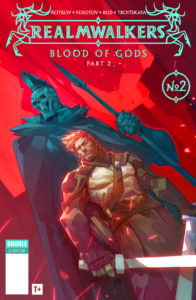
![]() I’m not sure what to make of this gorgeous comic book, translated from the original Russian.
I’m not sure what to make of this gorgeous comic book, translated from the original Russian.
The artwork in Realmwakers is gorgeous. Each panel looks like a single frozen animation cell, akin to the early issues of Gotham Academy. Aside from a few moments in fight scenes that are slightly difficult to follow, the quality holds up throughout these initial issues.
It’s lucky the art is so strong, as I don’t think the in medias res fight scene of the first issue is a particularly good introduction to the series. It delights in dancing around the core details of these characters, presenting action without giving us an engaging mystery.
Over the course of the first few issues, the concept unfurls itself. A young man is tasked by his elder to defeat rogue gods across different dimensions. He is granted a horrible, sentient sword that he is better off not using and he is accompanied by his lover, who has powers over the natural world, and their wolfman guide.
Every time this comic starts to be great there is a little moment of discontinuity to ruin the momentum – a herky-jerky quality to the translations that leaves some word balloons feeling a bit off.
I’m not sure I’ll return to this one.![]()
Silk (2016) #14, Marvel
![]() Silk is uneasy now that her family is united, so she takes a business trip (with mostly-dead boyfriend Spectro!) to assist JJJ on the West Coast – only to get sucked into a tertiary story to Clone Conspiracy!
Silk is uneasy now that her family is united, so she takes a business trip (with mostly-dead boyfriend Spectro!) to assist JJJ on the West Coast – only to get sucked into a tertiary story to Clone Conspiracy!
This is an average issue, but it’s got some funny bits and the artwork (not from regular artist Sana Ford) is quite delightful. I expect there was a chance that Robbie Thompson would be canceled with the resolution of the parent plot in #13 but got a brief extended lifespan by acquiescing to an event tie-in. While that gives us a few issues of plot to deal with, it doesn’t really give Silk a new long-term raison d’etre, which is likely why this wrapped up with #19.![]()
Spencer & Locke (2017) #1-4, Action Lab / Danger Zone
![]() This mean-spirited comic book is pure runaway male id pretending it is noir. It’s like kindergarten-level Alan Moore.
This mean-spirited comic book is pure runaway male id pretending it is noir. It’s like kindergarten-level Alan Moore.
The thin, derivative concept is violent, black mirror version of Calvin & Hobbes. The twists were all predictable if you’ve ever read a pulp fiction story. The execution simply piles an ever-increasing amount of VERY DARK plot points on our poor Calvin stand-in (including child abuse and sexual assault) in cartoonish flashback that makes him out to be the sort of awful delinquent Bart Simpson would be in real life.
Except, he’s also a delusional cop who imagines his partner is a stuffed cat.
The one thing I’ll say in its favor is that the comic strip style art is spot-on Bill Watters imitation, and the present day art consistently straddles the line between cartoon and noir. I’d definitely read this artist again; probably not the writer.![]()
The Skeptics (2016) #1-4, Black Mask Studios
![]() I loved the kitschy vibe of this 60s period throwback, which imagines a sort of scam artist X-Men trying to infiltrate the US government’s fervent wishes for their own super soldiers. The art is delightful send-up of a 60s pop art style with much more actual detail than you’d see in real retro art, much in the fashion of Mike Allred.
I loved the kitschy vibe of this 60s period throwback, which imagines a sort of scam artist X-Men trying to infiltrate the US government’s fervent wishes for their own super soldiers. The art is delightful send-up of a 60s pop art style with much more actual detail than you’d see in real retro art, much in the fashion of Mike Allred.
Unfortunately, the ambitious plot quickly fizzles into a sort of silly nuclear version of The Parent Trap. Moments of discontinuity between the script and the art pervade the series, repeatedly pulling you out of any brief momentum it manages to establish.
It’s a pity the story was such a flop, because the three main characters were genuinely interesting. It felt like there were a lot more ways to go after the charming first issue – including a lot more about skepticism and a lot less about trips to the bathroom (as even the character mock in this issue).![]()
Toil and Trouble (2015) #1, Boom! Studios
![]() This book follows one of the three Shakespearian witches as she returns from exile to help her sisters decide the fate of Scotland. It’s beautifully made, but invoking MacBeth isn’t exactly the best way to get me excited for a comic book (I am not a Shakespeare fan). That said, if you do love Scottish mythology and Shakespeare, this is right up your alley!
This book follows one of the three Shakespearian witches as she returns from exile to help her sisters decide the fate of Scotland. It’s beautifully made, but invoking MacBeth isn’t exactly the best way to get me excited for a comic book (I am not a Shakespeare fan). That said, if you do love Scottish mythology and Shakespeare, this is right up your alley!
I’m excited for this new feature! I’m a big Alice in Wonderland fan so I went and looked up issue 2 of “Return to Wonderland”, that was totally great, her arguing with the narration boxes!